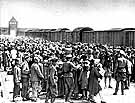 System of Death
System of Death
"Men to the left! Women to the right!" In his classic Holocaust memoir, Night, Elie Wiesel recalls that an SS man barked those orders as Hungarian Jews left the railroad cattle cars that transported them to Auschwitz-Birkenau in the spring of 1944. "Form fives!" Wiesel heard, as a selection began to determine who would go to the gas chambers. Such commands were part of death-camp methodology, a system invented by Nazis who became specialists in the destruction of Jewish life. The killing centers at Chelmno, Belzec, Sobibor, Treblinka, and Majdanek, as well as Birkenau, combined to make 1942 the most catastrophic year of the Holocaust. The destruction process varied from place to place, but the similarities increased the "Final Solution's" efficiency. As 1942 unfolded, packed rail transports regularly brought European Jews from ghettos and transit camps to the Nazi killing centers in Poland. When the trains reached their destinations, the dead had to be separated from the living. Next, those unable to walk were culled out and shot so that foot traffic on paths to the gas chambers could move more rapidly. The more-or-less able-bodied were segregated by sex, which split up families. Babies and small children remained with their mothers. At Belzec, Sobibor, and Treblinka, no further selection took place (except for a few people who were selected to work in the camp). Within hours virtually all arrivals in those three camps were gassed after giving up valuables, clothes, and hair. At Auschwitz (pictured), which was a huge slave-labor camp as well as a killing center, the Selektion was more detailed. Under the supervision of SS physicians such as Dr. Josef Mengele, and depending on the camp's needs, smaller or larger numbers of healthy men and women between the ages of 18 and 40 were singled out for "extermination through work." The new laborers were sheared, tattooed, registered, inadequately clothed, starved by meager food, sleep-deprived, sickened by deficient sanitation, condemned to exhausting labor, demoralized and sometimes tortured by their captors, and always endangered by further selections. During work hours, they confronted a brutal routine that racked body and spirit to the breaking point. Relatively few survived. At Majdanek and Auschwitz, those who failed the selection for slave labor walked on toward death. After their clothes and valuables were stripped away and their hair was shorn, they were gassed. Before their bodies were burned, gold fillings were harvested. After cremation, ashes that were not dumped in ponds or rivers became fertilizer. This process produced huge amounts of booty. The system ensured that nothing was wasted--except, of course, millions of Jewish lives.
Photo: Bilderdienst SYddeutscher Verlag
|
